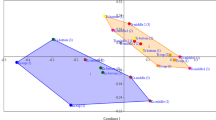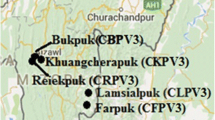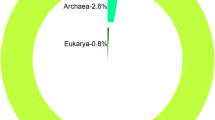Abstract
The Borra caves, the second largest subterranean karst cave ecosystem in the Indian sub-continent, are located at the Ananthagiri hills of Araku Valley in the Alluri district of Andhra Pradesh, India. The present investigation applied a shotgun metagenomic approach to gain insights into the microbial community structure, metabolic potential, and biosynthetic gene cluster (BGC) diversity of the microbes colonizing the surface of the speleothems from the aphotic zone of Borra caves. The taxonomic analysis of the metagenome data illustrated that the speleothem-colonizing core microbial community was dominated mainly by Alpha-, Beta-, and Gamma-Proteobacteria, Actinobacteria, Firmicutes, and Bacteroidetes. The key energy metabolic pathways analysis provides strong evidence of chemolithoautotrophic and chemoheterotrophic modes of nutrition in the speleothem-colonizing microbial community. Metagenome data suggests that sulfur reducers and sulfur-disproportionating microbes might play a vital role in energy generation in this ecosystem. Our metagenome data also suggest that the dissimilatory nitrifiers and nitrifying denitrifiers might play an essential role in conserving nitrogen pools in the ecosystem. Furthermore, metagenome-wide BGCs mining retrieved 451 putative BGCs; NRPS was the most abundant (24%). Phylogenetic analysis of the C domain of NRPS showed that sequences were distributed across all six function categories of the known C domain, including several novel subclades. For example, a novel subclade had been recovered within the LCL domain clade as a sister subclade of immunosuppressant cyclosporin encoding C domain sequences. Our result suggested that subterranean cave microbiomes might be a potential reservoir of novel microbial metabolites.





Similar content being viewed by others
References
Barton HA, Northup DE (2007) Geomicrobiology in cave environments: past, current and future perspectives. J Cave Karst Stud 69:163–178
de Paula CCP, Bichuette ME, Seleghim MHR (2020) Nutrient availability in tropical caves influences the dynamics of microbial biomass. Microbiologyopen 9:e1044. https://doi.org/10.1002/mbo3.1044
Simon KS, Benfield EF, Macko SA (2003) Food web structure and the role of epilithic biofilms in cave streams. Ecology 84:2395–2406. https://doi.org/10.1890/02-334
Northup DE, Lavoie KH (2001) Geomicrobiology of caves: a review. Geomicrobiol J 18:199–222. https://doi.org/10.1080/01490450152467750
Barton HA, Giarrizzo JG, Suarez P et al (2014) Microbial diversity in a Venezuelan orthoquartzite cave is dominated by the Chloroflexi (Class Ktedonobacterales) and Thaumarchaeota Group I.1c. Front Microbiol 5:615. https://doi.org/10.3389/fmicb.2014.00615
Jones DS, Tobler DJ, Schaperdoth I et al (2010) Community structure of subsurface biofilms in the thermal sulfidic caves of Acquasanta Terme, Italy. Appl Environ Microbiol 76:5902–5910. https://doi.org/10.1128/AEM.00647-10
Dhami NK, Mukherjee A, Watkin ELJ (2018) Microbial diversity and mineralogical-mechanical properties of calcitic cave speleothems in natural and in vitro biomineralization conditions. Front Microbiol 9:40. https://doi.org/10.3389/fmicb.2018.00040
Ortiz M, Neilson JW, Nelson WM et al (2013) Profiling bacterial diversity and taxonomic composition on speleothem surfaces in Kartchner Caverns, AZ. Microb Ecol 65:371–383. https://doi.org/10.1007/s00248-012-0143-6
Ortiz M, Legatzki A, Neilson JW et al (2014) Making a living while starving in the dark: metagenomic insights into the energy dynamics of a carbonate cave. ISME J 8:478–491. https://doi.org/10.1038/ismej.2013.159
D’Auria G, Artacho A, Rojas RA et al (2018) Metagenomics of bacterial diversity in Villa Luz caves with sulfur water springs. Genes 9:55. https://doi.org/10.3390/genes9010055
Park S, Cho Y-J, Jung D et al (2020) Microbial diversity in moonmilk of Baeg-nyong Cave, Korean CZO. Front Microbiol 11:613. https://doi.org/10.3389/fmicb.2020.00613
Zepeda Mendoza ML, Lundberg J, Ivarsson M et al (2016) Metagenomic analysis from the interior of a speleothem in Tjuv-Ante’s Cave, Northern Sweden. PLoS ONE 11:e0151577. https://doi.org/10.1371/journal.pone.0151577
Jones DS, Albrecht HL, Dawson KS et al (2012) Community genomic analysis of an extremely acidophilic sulfur-oxidizing biofilm. ISME J 6:158–170. https://doi.org/10.1038/ismej.2011.75
Wiseschart A, Mhuantong W, Tangphatsornruang S et al (2019) Shotgun metagenomic sequencing from Manao-Pee cave, Thailand, reveals insight into the microbial community structure and its metabolic potential. BMC Microbiol 19:144. https://doi.org/10.1186/s12866-019-1521-8
Tomczyk-Żak K, Zielenkiewicz U (2016) Microbial diversity in caves. Geomicrobiol J 33:20–38. https://doi.org/10.1080/01490451.2014.1003341
Hershey OS, Barton HA (2018) The microbial diversity of caves. In: Moldovan O, Kováč Ľ, Halse S (eds) Cave ecology. Springer, Cham, pp 69–90
Rokas A, Mead ME, Steenwyk JL et al (2020) Biosynthetic gene clusters and the evolution of fungal chemodiversity. Nat Prod Rep 37:868–878. https://doi.org/10.1039/C9NP00045C
Medema MH, Kottmann R, Yilmaz P et al (2015) Minimum information about a biosynthetic gene cluster. Nat Chem Biol 11:625–631. https://doi.org/10.1038/nchembio.1890
Cimermancic P, Medema MH, Claesen J et al (2014) Insights into secondary metabolism from a global analysis of prokaryotic biosynthetic gene clusters. Cell 158:412–421. https://doi.org/10.1016/j.cell.2014.06.034
Rangseekaew P, Pathom-Aree W (2019) Cave actinobacteria as producers of bioactive metabolites. Front Microbiol 10:387. https://doi.org/10.3389/fmicb.2019.00387
Zada S, Sajjad W, Rafiq M et al (2022) Cave microbes as a potential source of drugs development in the modern era. Microb Ecol 84:676–687. https://doi.org/10.1007/s00248-021-01889-3
Ghosh S, Kam G, Nijjer M et al (2020) Culture dependent analysis of bacterial diversity in Canada’s Raspberry Rising Cave revealed antimicrobial properties. Int J Speleol 49:43–53. https://doi.org/10.5038/1827-806X.49.1.2291
Ghosh S, Kuisiene N, Cheeptham N (2017) The cave microbiome as a source for drug discovery: reality or pipe dream? Biochem Pharmacol 134:18–34. https://doi.org/10.1016/j.bcp.2016.11.018
Baskar S, Baskar R, Lee N et al (2008) Precipitation of iron in microbial mats of the spring waters of Borra Caves, Vishakapatnam, India: some geomicrobiological aspects. Environ Geol 56:237–243. https://doi.org/10.1007/s00254-007-1159-y
Baskar S, Baskar R, Thorseth IH et al (2012) Microbially induced iron precipitation associated with a neutrophilic spring at Borra Caves, Vishakhapatnam, India. Astrobiology 12:327–346. https://doi.org/10.1089/ast.2011.0672
Griffin DW, Gray MA, Lyles MB, Northup DE (2014) The transport of nonindigenous microorganisms into caves by human visitation: a case study at Carlsbad Caverns National Park. Geomicrobiol J. https://doi.org/10.1080/01490451.2013.815294
Chen S, Zhou Y, Chen Y, Gu J (2018) fastp: an ultra-fast all-in-one FASTQ preprocessor. Bioinformatics 34:i884–i890. https://doi.org/10.1093/bioinformatics/bty560
Li D, Liu C-M, Luo R et al (2015) MEGAHIT: an ultra-fast single-node solution for large and complex metagenomics assembly via succinct de Bruijn graph. Bioinformatics 31:1674–1676. https://doi.org/10.1093/bioinformatics/btv033
Patel RK, Jain M (2012) NGS QC Toolkit: a toolkit for quality control of next generation sequencing data. PLoS ONE 7:e30619. https://doi.org/10.1371/journal.pone.0030619
Menzel P, Ng KL, Krogh A (2016) Fast and sensitive taxonomic classification for metagenomics with Kaiju. Nat Commun 7:11257. https://doi.org/10.1038/ncomms11257
Dong X, Strous M (2019) An integrated pipeline for annotation and visualization of metagenomic contigs. Front Genet 10:999. https://doi.org/10.3389/fgene.2019.00999
Kanehisa M (2002) The KEGG databases at GenomeNet. Nucleic Acids Res 30:42–46. https://doi.org/10.1093/nar/30.1.42
Blin K, Shaw S, Kloosterman AM et al (2021) antiSMASH 6.0: improving cluster detection and comparison capabilities. Nucleic Acids Res 49:W29–W35. https://doi.org/10.1093/nar/gkab335
Ziemert N, Podell S, Penn K et al (2012) The natural product domain seeker NaPDoS: a phylogeny based bioinformatic tool to classify secondary metabolite gene diversity. PLoS ONE 7:e34064. https://doi.org/10.1371/journal.pone.0034064
Legatzki A, Ortiz M, Neilson JW et al (2011) Bacterial and archaeal community structure of two adjacent calcite speleothems in Kartchner Caverns, Arizona, USA. Geomicrobiol J 28:99–117. https://doi.org/10.1080/01490451003738465
Baskar S, Baskar R, Kaushik A (2007) Evidences for microbial involvement in the genesis of speleothem carbonates, Borra Caves, Visakhapatnam, India. Curr Sci 92:350–355
Mudgil D, Paul D, Baskar S et al (2022) Cultivable microbial diversity in speleothems using MALDI-TOF spectrometry and DNA sequencing from Krem Soitan, Krem Lawbah, Krem Mawpun, Khasi Hills, Meghalaya, India. Arch Microbiol 204:495. https://doi.org/10.1007/s00203-022-02916-8
Berg IA (2011) Ecological aspects of the distribution of different autotrophic CO2 fixation pathways. Appl Environ Microbiol 77:1925–1936. https://doi.org/10.1128/AEM.02473-10
Markert S, Arndt C, Felbeck H et al (2007) Physiological proteomics of the uncultured endosymbiont of Riftia pachyptila. Science 315:247–250. https://doi.org/10.1126/science.1132913
Hanson RS, Hanson TE (1996) Methanotrophic bacteria. Microbiol Rev 60:439–471. https://doi.org/10.1128/mr.60.2.439-471.1996
Chistoserdova L (2011) Modularity of methylotrophy, revisited. Environ Microbiol 13:2603–2622. https://doi.org/10.1111/j.1462-2920.2011.02464.x
Lidstrom ME (2006) Aerobic methylotrophic prokaryotes. In: Dworkin M, Falkow S, Rosenberg E et al (eds) The prokaryotes. Springer, New York, pp 618–634
Kalyuzhnaya MG, De Marco P, Bowerman S et al (2006) Methyloversatilis universalis gen. nov., sp. nov., a novel taxon within the Betaproteobacteria represented by three methylotrophic isolates. Int J Syst Evol Microbiol 56:2517–2522. https://doi.org/10.1099/ijs.0.64422-0
Chen Y, Wu L, Boden R et al (2009) Life without light: microbial diversity and evidence of sulfur- and ammonium-based chemolithotrophy in Movile Cave. ISME J 3:1093–1104. https://doi.org/10.1038/ismej.2009.57
Muyzer G, Stams AJM (2008) The ecology and biotechnology of sulphate-reducing bacteria. Nat Rev Microbiol 6:441–454. https://doi.org/10.1038/nrmicro1892
Klotz MG, Bryant DA, Hanson TE (2011) The microbial sulfur cycle. Front Microbiol 2:241. https://doi.org/10.3389/fmicb.2011.00241
Finster K (2008) Microbiological disproportionation of inorganic sulfur compounds. J Sulfur Chem 29:281–292. https://doi.org/10.1080/17415990802105770
Krämer M, Cypionka H (1989) Sulfate formation via ATP sulfurylase in thiosulfate- and sulfite-disproportionating bacteria. Arch Microbiol 151:232–237. https://doi.org/10.1007/BF00413135
Engel AS (2007) Observations on the biodiversity of sulfidic karst habitats. J Cave Karst Stud 69:187–206
Rütting T, Boeckx P, Müller C, Klemedtsson L (2011) Assessment of the importance of dissimilatory nitrate reduction to ammonium for the terrestrial nitrogen cycle. Biogeosciences 8:1779–1791. https://doi.org/10.5194/bg-8-1779-2011
Jia M, Winkler MKH, Volcke EIP (2020) Elucidating the competition between heterotrophic denitrification and DNRA using the resource-ratio theory. Environ Sci Technol 54:13953–13962. https://doi.org/10.1021/acs.est.0c01776
Kimble JC, Winter AS, Spilde MN et al (2018) A potential central role of thaumarchaeota in N-Cycling in a semi-arid environment, Fort Stanton Cave, Snowy River passage, New Mexico, USA. FEMS Microbiol Ecol 94:fiy173. https://doi.org/10.1093/femsec/fiy173
Zhu X, Burger M, Doane TA, Horwath WR (2013) Ammonia oxidation pathways and nitrifier denitrification are significant sources of N2O and NO under low oxygen availability. Proc Natl Acad Sci 110:6328–6333. https://doi.org/10.1073/pnas.1219993110
Shaw LJ, Nicol GW, Smith Z et al (2006) Nitrosospira spp. can produce nitrous oxide via a nitrifier denitrification pathway. Environ Microbiol 8:214–222. https://doi.org/10.1111/j.1462-2920.2005.00882.x
Quince C, Walker AW, Simpson JT et al (2017) Shotgun metagenomics, from sampling to analysis. Nat Biotechnol 35:833–844. https://doi.org/10.1038/nbt.3935
Salazar-Hamm PS, Hathaway JJM, Winter AS et al (2022) Great diversity of KS α sequences from bat-associated microbiota suggests novel sources of uncharacterized natural products. FEMS Microb 3:xtac012. https://doi.org/10.1093/femsmc/xtac012
Hug J, Bader C, Remškar M et al (2018) Concepts and methods to access novel antibiotics from actinomycetes. Antibiotics 7:44. https://doi.org/10.3390/antibiotics7020044
Covington BC, Spraggins JM, Ynigez-Gutierrez AE et al (2018) Response of secondary metabolism of hypogean actinobacterial genera to chemical and biological stimuli. Appl Environ Microbiol. https://doi.org/10.1128/AEM.01125-18
Ren H, Wang B, Zhao H (2017) Breaking the silence: new strategies for discovering novel natural products. Curr Opin Biotechnol 48:21–27. https://doi.org/10.1016/j.copbio.2017.02.008
Gosse JT, Ghosh S, Sproule A et al (2019) Whole genome sequencing and metabolomic study of cave Streptomyces isolates ICC1 and ICC4. Front Microbiol 10:1020. https://doi.org/10.3389/fmicb.2019.01020
Cheeptham N, Sadoway T, Rule D et al (2013) Cure from the cave: volcanic cave actinomycetes and their potential in drug discovery. Int J Speleol 42:35–47. https://doi.org/10.5038/1827-806X.42.1.5
Acknowledgements
This work was funded by GITAM: Research Seed Grants (F. No: 2021/0003) awarded to BS. We want to acknowledge the Andhra Pradesh State Tourism Department for allowing BS to collect the samples from Borra caves.
Author information
Authors and Affiliations
Contributions
BS: original concept, sampling, DNA work, data analysis, drafting, and editing manuscript; SS: data analysis, drafting, and editing manuscript; RB: data analysis, drafting, and editing manuscript.
Corresponding author
Ethics declarations
Conflict of interest
The authors declare no conflict of interests.
Additional information
Publisher's Note
Springer Nature remains neutral with regard to jurisdictional claims in published maps and institutional affiliations.
Supplementary Information
Below is the link to the electronic supplementary material.
284_2023_3431_MOESM1_ESM.xlsx
Supplementary file 1: Details of taxonomic affiliations of Borra caves speleothem metagenomic contigs belonging to Proteobacteria, Actinobacteria, Firmicutes, and Bacteroidetes groups. (XLSX 809 KB)
284_2023_3431_MOESM2_ESM.xlsx
Supplementary file 2: Details of taxonomic affiliations of Borra caves spring water metagenomic contigs belonging to Proteobacteria, Actinobacteria, FCB, Terrabacteria, and PVC groups. (XLSX 681 KB)
284_2023_3431_MOESM3_ESM.pdf
Supplementary file 3: Details of genes assigned to the different types of metabolism and metabolic pathways and their relative abundance. (PDF 193 KB)
284_2023_3431_MOESM4_ESM.pdf
Supplementary file 4: KEGG map for major energy metabolic pathways detected in Borra caves metagenome, including methane metabolism, carbon fixation, sulfur metabolism, and nitrogen metabolism. (PDF 194 KB)
284_2023_3431_MOESM5_ESM.xlsx
Supplementary file 5: Biosynthetic gene cluster abundance within the Borra caves speleothem metagenome contigs. BLASTP and NaPDoS analyses of C and KS domains of NRPS and PKS. BLASTP analysis of core genes of terpene biosynthetic gene clusters. (XLSX 64 KB)
284_2023_3431_MOESM6_ESM.png
Supplementary file 6: Maximum likelihood tree of Ketosynthase domains (KS domain) against the NaPDoS domain database. Natural products are color-coded according to their bioactivity. The branches of the KS domain classes were colored on the tree. Confidence values are shown on nodes. (PNG 1644 KB)
284_2023_3431_MOESM7_ESM.tif
Supplementary file 7: Relative abundance of bacterial phylum in Borra cave speleothem and spring water metagenomic libraries. (TIF 1341 KB)
Rights and permissions
Springer Nature or its licensor (e.g. a society or other partner) holds exclusive rights to this article under a publishing agreement with the author(s) or other rightsholder(s); author self-archiving of the accepted manuscript version of this article is solely governed by the terms of such publishing agreement and applicable law.
About this article
Cite this article
Samanta, B., Sharma, S. & Budhwar, R. Metagenome Analysis of Speleothem Microbiome from Subterranean Cave Reveals Insight into Community Structure, Metabolic Potential, and BGCs Diversity. Curr Microbiol 80, 317 (2023). https://doi.org/10.1007/s00284-023-03431-9
Received:
Accepted:
Published:
DOI: https://doi.org/10.1007/s00284-023-03431-9




